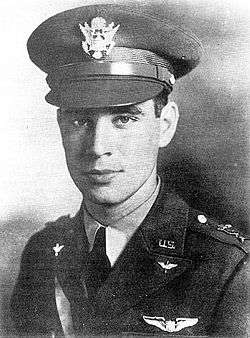Boyd Wagner
| Boyd Wagner | |
|---|---|
 | |
| Born |
October 26, 1916 Cambria County, Pennsylvania |
| Died |
November 29, 1942 (aged 26) Walton County, Florida |
| Place of burial | Grandview Cemetery, Johnstown |
| Allegiance |
|
| Service/branch |
United States Army Air Corps United States Army Air Force |
| Years of service | 1938 – 1942 |
| Rank | Lieutenant Colonel |
| Unit | |
| Battles/wars | World War II |
| Awards | |
Lieutenant Colonel Boyd David "Buzz" Wagner (October 26, 1916 – November 29, 1942) was an American aviator and the first United States Army Air Corps (USAAC) fighter ace of World War II.
Wagner was born October 26, 1916 in Emeigh, Cambria County, Pennsylvania, the son of Boyd M. and Elizabeth M. Moody Wagner.[1]
Life
He grew up in Nanty-Glo, near Johnstown, and studied aeronautical engineering at the University of Pittsburgh for three years before joining the Army Air Corps. He completed flight training in June 1938 and was assigned to duty in the Philippines with the 24th Pursuit Group. He was soon given command of the 17th Pursuit Squadron.[2]
He was nicknamed “Buzz” because it was said he could buzz the camouflage off a hangar roof.[3]
Wagner was a first lieutenant commanding the 17th Pursuit Squadron stationed at Nichols Field on December 8, 1941, when the first Japanese air attacks struck the Philippines. On December 12, Wagner took off in a Curtiss P-40 on a solo reconnaissance mission over Aparri, where he was attacked by Japanese Mitsubishi A6M Zero fighters. He dove away from the attacking planes and then returned and shot down two of them. He was attacked by more Zeros as he strafed a nearby Japanese airfield and subsequently destroyed two of these planes as well before returning to Clark Field.[1]
On December 17, he led an attack on a Japanese airstrip near Vigan with Lieutenants Allison W. Strauss and Russell M. Church, Jr. Church was killed in the attack and posthumously received the Distinguished Service Cross. Wagner and Strauss continued the strafing attack on the airfield, damaging and destroying numerous Japanese planes. A sole Japanese Zero took off and attacked Wagner's plane, but he chopped his throttle and caused the Zero to overshoot his plane. Once in position behind the Zero, Wagner was able to shoot it down, becoming the first USAAF ace of World War II and earning a Distinguished Service Cross.[1]
At least one source states that Wagner's first five kills were not Zeros, but were IJAAF Nakajima Ki-27 "Nate" fighter planes. This source does confirm his later kills were reported as Zeros, but were impossible to verify from Japanese records.[4]
Attacking the Japanese again at Vigan on December 22, his plane was struck by enemy fire and he was wounded by glass splinters which struck his face and eyes. He returned to base safely and evacuated to Australia in January 1942.[1]
Wagner was promoted to lieutenant colonel and assigned in April to the 8th Fighter Group in New Guinea flying the Bell P-39. At the time, he was the youngest lieutenant colonel in the US Army.[3] On April 30, 1942 he shot down three Zeros, bringing his air-to-air kill total to eight.[1]
It was decided that Wagner's experience and knowledge would be more valuable back in the U.S., training fighter pilots and as a liaison to the Curtiss P-40 plant in Buffalo, New York, to help engineers improve the P-40's combat performance. Despite his protests at being pulled out of combat, he was sent home to the United States.[2]
Death
On a routine flight in a P-40K from Eglin Field, Florida to Maxwell Field, Alabama on November 29, 1942, Wagner's plane disappeared.[2][3] After an extensive search, what was left of the P-40 and Wagner's remains were found almost six weeks later in January 1943, 25 miles east of Eglin. The cause of the crash, if known, was never revealed.
Wagner's partial remains were returned to Johnstown for burial. An estimated 15,000 to 20,000 mourners attended his funeral at Grandview Cemetery in January 1943. Both Time and Life covered the event.[3]
After five years of research, retired Air Force Colonel Jim Moschgat rediscovered what he believed to be the crash site of Wagner's plane in Florida and found artifacts that tentatively confirmed the crash site was the correct one. Human remains were found at the site in 2008.[3] In 2010, the remains were confirmed as being Lieutenant Colonel Wagner’s. These additional remains were buried with full military honors, to include a fly over by the U.S. Air Force at the Grandview Cemetery in Johnstown.[5]
Honors
In addition to the Distinguished Service Cross, Wagner also received the Purple Heart and the Distinguished Flying Cross.
Two schools at Clark Air Base were named in honor of Boyd Wagner: Wagner High School and Wagner Middle School.
See also
References
- 1 2 3 4 5 Stephen Sherman (December 2002). "Lt. Col. Boyd "Buzz" Wagner: First USAAF Ace of WW2". AcePilots.com. Retrieved September 8, 2009.
- 1 2 3 Frisbee, John L. (1996). "Valor: AAF's First Ace". Air Force Magazine. Air Force Association. 79 (9). Archived from the original on November 24, 2010. accessed September 8, 2009
- 1 2 3 4 5 Deann Hadix-Cardarella (April 12, 2009). "Researcher's work shines the spotlight on World War II hero 'Buzz' Wagner". The Tribune-Democrat. accessed September 8, 2009
- ↑ Tomasz Gronczewski. "Bell P-39 Airacobra in USAAF Service". Retrieved September 9, 2009.
- ↑ Frank Sojak (October 19, 2010). "Events to honor WWII flying ace". The Tribune-Democrat.